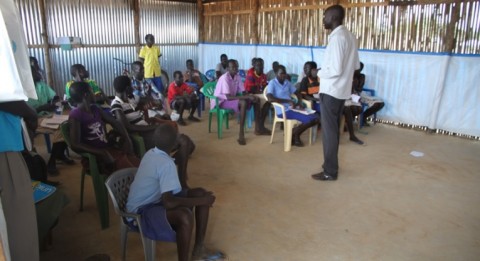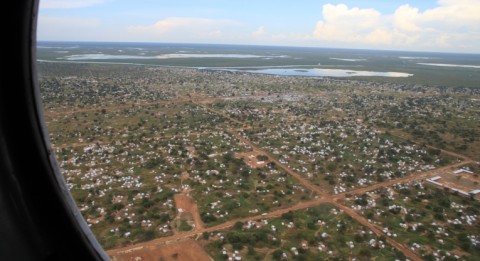Hundreds of children get to go to school in South Sudan
750 children were able to continue their suspended schooling, when the temporary schools and classrooms built by FCA were opened in Mingaman, South Sudan. When all the constructions are finished,there will be classrooms for over three thousand students. “Give us peace and right to education” sang the school’s choir in the inauguration last Saturday. Other children, their parents and the local authorities were listening.
Last December’s erupted violence has suspended schooling for hundreds of thousands of children in South Sudan. The classrooms built by Finn Church Aid alleviate the problem of lack of schools in the country. In addition to the just finished sixteen classrooms, sixteen more will be built in the center of refugee housing. Students are enrolling constantly, and already there has been recruitment of sixteen teachers to the Mingaman refugee school.
One of the new teachers is Atem Kuer. The class is 5B and there are 37 students. The students are between 15 and 20 years of age. Many have had their schooling suspended for a long time, or it has never even begun, due to the long civil war that preceded the independence of South Sudan. The country is one of the poorest in Africa, and children are needed at home, or as shepherds. The benefits of schooling seem distant and unattainable.
A chalkboard is Atem Kuer’s only tool. The students don’t have any school books, notepads or pens. There are no desks either, but it doesn’t matter right now, because the teacher is teaching the difference between organic and inorganic matters. A science class is being taught.
“I want to be a teacher”

Atem Kuer is teaching class 5B. He’s trying to demonstrate the difference between organic and inorganic matter at science class, without the help of any teaching tools.
Amyang Wuer is sixteen. His family fled Bor, the capital of Jonglei state in December. After roaming around for a while, the mother, father and the six children ended up in Mingaman. Amyang is the only one from his family who’s in school. His other siblings are illiterate and will remain as herders for their family’s cattle.
“I like mathematics and science subjects. I want to learn and get a profession for myself. I’m hoping that I’ll become a teacher”, Amyang shares his dreams under the corrugated iron roof of the temporary school.
The population of Mingaman doubled
Currently, there are almost hundred thousand residents in Mingaman. Half of them are internally displaced people. Their tents dot the constant scenery of Mingaman. Mingaman is the capital of Awerial province in Lakes state. Even though there are restlessness and violence all around, Mingaman has remained peaceful, partly because it’s ethnically homogenous Dinka tribe’s area.
Most of the conflicts in South Sudan, an area twice the size of Finland, are to do with land, land ownership and its usage. Still, there is plenty of untouched and unused land.
“Education is an investment for the future”
Deng Tong, the commissioner of Mingaman understands the value of education.
“It is a long-term investment. There has been a shortage of schools here for a long time, and building these temporary learning spaces also benefit the original population”, he ponders.
According to careful estimates, over 40 000 school-aged children are without schools, even after the ones built by FCA. The commissioner says that Mingaman has been sought-after settling place because it has good water supplies. Now the schools will act as an added incentive. Many of the internally displaced people are also from a relative distance away so they can visit their home, when it’s safe.
“We are fine with the internally displaced settling here more permanently”, commissioner Deng Tong says.
Mät means unity
One of the classroom’s outer walls is decorated with a banner made for the inauguration of the school.
“Mät Academia will be opened here”.
“Mät is Dinka language and means unity. In these classrooms, there is a lot of unity: the displaced children and local children go to school together. The town has welcomed the internally displaced and accepted them as part of the community. Finnish Finn Church Aid has provided the funding, and local professionals have built these classrooms”, James Marer, the director of Mingaman school system, says.
The schools are of light structure. The walls are made of reed, and the lower part is fortified with tarps. The roofs are corrugated iron. The constructions were delayed due to exceptionally heavy rains. There were also difficulties in getting the construction materials from the capital Juba, because the rainfall made the roads inaccessible.
Schools bring hope to everyone

The population of Mingaman has doubled in the last ten months. The internally displaced people live in tents provided by humanitarian organisations.
The civil war and impertinence has lasted for long time. It almost seems like people have gotten used to an extremely meagre refugee life under the tents and covers bearing different organisations’ emblems. However, the opportunity to attend school seems to have revitalised the whole community.
The inauguration of the school lasted many hours under the hot midday sun. The first ones that got tired were the balloons. They began to pop. The patience of children was also tested. They tried to make their way next to the guests, but the older students shooed them back to their places. Reggae-tone was selected as the inauguration music.
Text and photos: Hilkka Hyrkkö